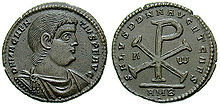Constantius II
The brothers divided the empire among themselves, with Constantius receiving Greece, Thrace, the Asian provinces, and Egypt in the east.
In the meantime, his brothers Constantine and Constans warred over the western provinces of the empire, leaving the former dead in 340 and the latter as sole ruler of the west.
Unwilling to accept Magnentius as co-ruler, Constantius waged a civil war against the usurper, defeating him at the battles of Mursa Major in 351 and Mons Seleucus in 353.
Shortly thereafter, in 355, Constantius promoted his last surviving cousin, Gallus's younger half-brother Julian, to the rank of Caesar.
The war against the Sasanians, which had been in a lull since 350, erupted with renewed intensity in 359 and Constantius travelled to the east in 360 to restore stability after the loss of several border fortresses.
No battle was fought, as Constantius became ill and died of fever on 3 November 361 in Mopsuestia, allegedly naming Julian as his rightful successor before his death.
[7] In 336, religious unrest in Armenia and tense relations between Constantine and king Shapur II caused war to break out between Rome and Sassanid Persia.
[8] Though he made initial preparations for the war, Constantine fell ill and sent Constantius east to take command of the eastern frontier.
[8][9] Before Constantius arrived, the Persian general Narses, who was possibly the king's brother, overran Mesopotamia and captured Amida.
[13] Soon after his father's death, the army massacred his relatives descended from the marriage of his paternal grandfather Constantius Chlorus to Flavia Maximiana Theodora, though the details are unclear.
[20][16] Burgess considered the latter version to be “consistent with all the evidence,” pointing to multiple factors that he believed lined up with the massacre being a planned attack rather than a spontaneous mutiny - the lack of high-profile punishments as a response, the sparing of all women, the attempted damnatio memoriae on the deceased, and the exile of the survivors Gallus and Julian.
[24][25] While Constantius was away from the eastern frontier in early 337, King Shapur II assembled a large army, which included war elephants, and launched an attack on Roman territory, laying waste to Mesopotamia and putting the city of Nisibis under siege.
These conflicts were mainly limited to Sassanid sieges of the major fortresses of Roman Mesopotamia, including Nisibis (Nusaybin), Singara, and Amida (Diyarbakir).
[36] However, feeling that the east still required some sort of imperial presence, he elevated his cousin Constantius Gallus to caesar of the eastern provinces.
[39] Before facing Magnentius, Constantius first came to terms with Vetranio, a loyal general in Illyricum who had recently been acclaimed emperor by his soldiers.
Rather than pursuing his opponent, however, Constantius turned his attention to securing the Danubian border, where he spent the early months of 352 campaigning against the Sarmatians along the middle Danube.
However, after some convincing by one of Constantius's agents,[52] Gallus continued his journey west, passing through Constantinople and Thrace to Poetovio (Ptuj) in Pannonia.
[67] There were also frequent episodes of ordinary Christians destroying, pillaging and desecrating many ancient pagan temples, tombs and monuments.
"Unfortunately for his memory the theologians whose advice he took were ultimately discredited and the malcontents whom he pressed to conform emerged victorious," writes the historian A. H. M. Jones.
[80] This included edicts to limit the ownership of slaves by Jewish people[81] and banning marriages between Jews and Christian women.
The same year, he forced Sarmatian and Quadi invaders out of Pannonia and Moesia Inferior, then led a successful counter-attack across the Danube.
[87] In the winter of 357–58, Constantius received ambassadors from Shapur II who demanded that Rome restore the lands surrendered by Narseh.
In 360, when news reached Constantius that Shapur II had destroyed Singara (Sinjar),[95] and taken Kiphas (Hasankeyf), Amida (Diyarbakır),[96] and Ad Tigris (Cizre),[97] he decided to travel east to face the re-emergent threat.
[98][99][100][i] On account of the immediate Sassanid threat, Constantius was unable to directly respond to his cousin's usurpation, other than by sending missives in which he tried to convince Julian to resign the title of augustus and be satisfied with that of caesar.
The sources claim that realising his death was near, Constantius had himself baptised by Euzoius, the Semi-Arian bishop of Antioch, and then declared that Julian was his rightful successor.
[115] Third and lastly, in 361, to Faustina, who gave birth to Constantius's only child, a posthumous daughter named Constantia, who later married Emperor Gratian.
2: Constantine's children According to DiMaio and Frakes, “...Constantius is hard for the modern historian to fully understand both due to his own actions and due to the interests of the authors of primary sources for his reign.”[118] A. H. M. Jones writes that he "appears in the pages of Ammianus as a conscientious emperor but a vain and stupid man, an easy prey to flatterers.
To orthodox churchmen he was a bigoted supporter of the Arian heresy, to Julian the Apostate and the many who have subsequently taken his part he was a murderer, a tyrant and inept as a ruler".
Eutropius wrote of him,[121]He was a man of a remarkably tranquil disposition, good-natured, trusting too much to his friends and courtiers, and at last too much in the power of his wives.
He conducted himself with great moderation in the commencement of his reign; he enriched his friends, and suffered none, whose active services he had experienced, to go unrewarded.












